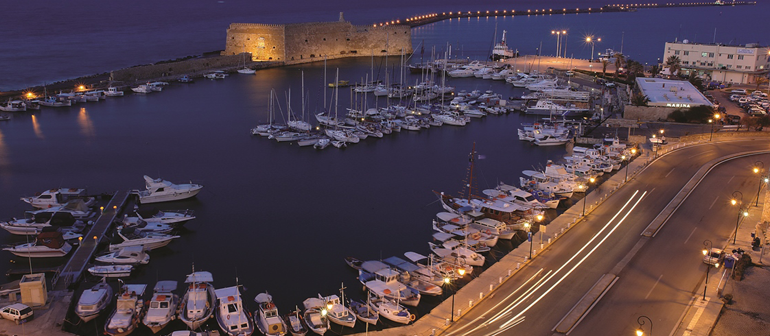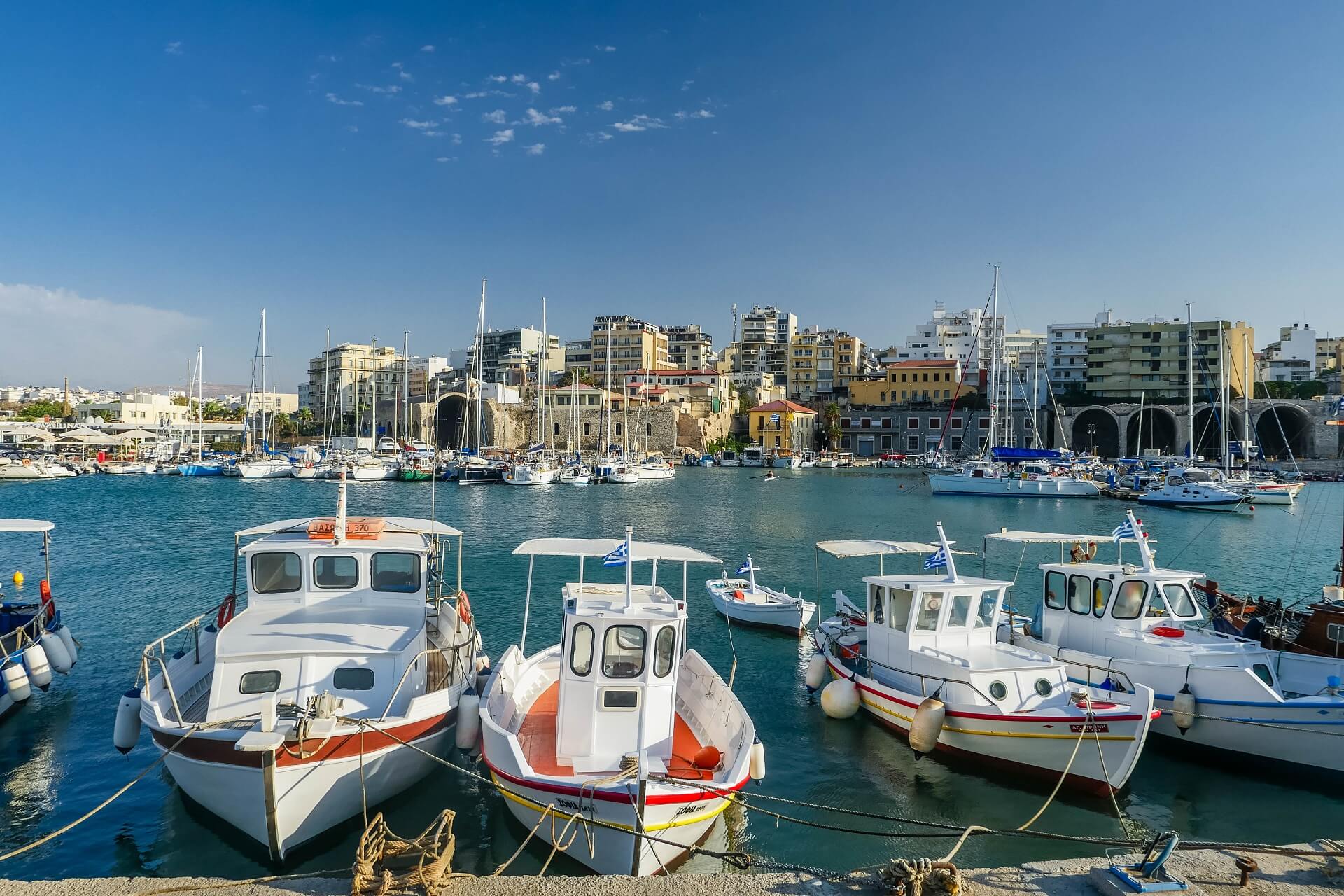
Heraklion Town Greece
Heraklion or Iraklion the birthplace of El Greco and Nikos Kazantzakis. Stay long enough and you can even begin to like the place; the sea, as well as the area’s antiquities, excellent food and friendly, welcoming people make this place a delightful place to visit.
Heraklion is Crete’s biggest city (among Chania, Rethimno, Agios Nikolaos, Sitia, Ierapetra), whose emblem is the Venetian fortress of Koules and it harmoniously combines a multilingual past as Byzantine churches standing next to the Venetian mansions and Turkish fountains and a thriving present with many restaurants, coffee shops and bars that cater to every taste.

Heraklion Port – Heraklion Crete
Heraklion or Iraklion has undergone a significant makeover in recent years – this is a result of being chosen as an Olympic city …partly bu mostly because of the city’s increasing prosperity. Infrastructure works have included redevelopment of the waterfront ( have a nice walk there ), improved roads and a city bypass to ease traffic congestion and maybe the most important much of the historic centre has been turned into pleasant pedestrian strips. Let’s see how you could spent one or two days in Heraklion.
Do You Need Taxi Or Minibus Transfer To Heraklion? Book Now!
PLATANIAS TAXI TRANSFER | CRETE | TRIP IEAS | HERAKLION
What to see and do!
You have a day or two to spend in Heraklion, the main city and key business centre of Crete. The city is also a major cruise destination. Beyond the crazed progress of moped riders, noisy scooters and a battered, out-of-control look to the city, there is much to do and plenty of things worth seeing.
Apart from shopping and the designer clothes on Daedalou Street (“Daydaloo”), there are many small shops off all the main streets which sell those local products which normally are used when you live in Crete. Just have a look along 1866 Street and more so its side streets – you may find a curio distinctly different from more typical “gifts” offered to visitors in gift shops.
The famous tourist attraction, the Saturday market that was by the port, an almost kilometre long display of fruit and vegetables and sundry items – has now sadly moved to an obscure suburb.This is a brief guide to some of the well known and some less well known enjoyments and rewards of Heraklion:
Cultural Offerings
The enormous Archaeological Museum (converted from an old power station well before the idea of using the old Battersea power station in London as an art gallery) on one corner of the central Eleftherias Square, collects together many of the finds from Knossos, Archanes, Phaestos, Zakros and many other archeological sites in Crete.
The museum spans a period starting several thousand years ago, through the Minoan, post-Minoan and later periods. Popular highlights include the Phaestos disc, classic Hellenic and Roman sculptures, frescoes, jewelry, wall-paintings and pottery. A selection of guide books is available at the museum shop – best to buy one to gain some insight into the items that make up this substantial collection.
It’s a good idea to start early in the morning or late in the day during the summer months to avoid a rush-hour style of viewing – this is a very popular destination.Open: every day 08.00 to 19.30 summer, 08.30 to 17.00 winter. Monday opening is from 12.00. December to Ferbuary closing time is 15.00. Closed on public Holidays. Tel: 2810-279086, 279087. Admission: 6.00 euros. Combined museum and Knossos ticket: 10.00 euros.
Important Note: All museum surrounds and the original museum building are being completely rebuilt. The date of completion is undetermined. A temporary, partial exhibition (of 400 exhibits) is open at a new annex behind the museum. The full exhibition will be displayed again when works have been completed.
History Museum on Sophocleus Venizelou. Easy way to find it is to walk to the bottom of 25th August and at the end, turn left along the seafront – it’s about half a kilometre along on your left (some nice cafes and tavernas have opened in the square beside it). Open: 09.00 to 15.00 every day, except Saturday 09.00-14.00, Sunday closed. Tel: 2810-283219.
The Battle of Crete Museum. Walk down the side of the Archaeological museum on Hatzidaki and at the end, where it meets Bufor is this small but informative gem. Open: 09.00 to 15.00 every day except Saturday & Sunday. Free entrance. Tel: 2810-346554.
The Venetian Loggia on 25th August Street (“Avgoostoo Eekosi Penday”), 50 metres down the street from “Lion Square” (Morosini or Venizelos Square on maps) on the right, is now the city hall of Heraklion. You can walk in a take a quick look. This is a two-storeay Venetian mansion completed in 1628, whch used to be a meeting place for the nobles of Crete.
If you take the left turn instead (off 25th August) you enter Theotokopoulou or El Greco square where the OTE (Otay) buildings house public telephone and mobile facilities. Also if you are in need of a supermarket you will find Halkiadakis on the next side of this square. The Municipal Gallery and Basilica of St. Mark has an ever-changing variety of exhibitions from early photographs of Crete, to specific works of art – have a look to see if there is a current exhibition. Opposite “Lion Square”.
The Koules Venetian Fortress on the harbour walls, built in the early 1500’s. Both for the impressive stone mass of its fortification and unfathomably solid walls, the pleasure of views from its turret and roof, restored interior and exterior reliefs of the Lion of St. Mark. Open: 09.00 to 15.00. From 1 July to 31 October, open: 08.00 to 19.30. (We find that in reality their opening times seem rather unpredictable!) Tel: 2810-246211 Admission: 1.50 euros.
The Natural History Museum of Crete. 10 minutes walk along the sea front from the bottom of 25th of August street – turn left as you face the sea (same direction as for the History Museum). The museum is in the well-converted old electricity power plant for Heraklion. Has wonderful displays and good descriptive details about the flora and fauna, the wildlife, of Crete. An exciting feature is the “experience an earthquake” platform in the basement of the museum.
Another great place to visit with your children: the new Aquarium (“CretAquarium” or “Thalassocosmos”). A 5000 square meter structure, it is both a research center (housing the Institute of Marine Biology & Genetics and the Institute of Oceanography) and a fun, impressive aquarium with 32 tanks (representing interesting underwater Cretan sea landscapes) and 50 viewing points. 2500 organisms of 200 Mediterranean marine species, from hunter sharks to lobsters, to colorful jellyfish.
Touch screens provide information in 5 languages. 15 km east of Heraklion, within what was the American base of Gournes (there are buses to it from the center of town). Open 365 days/year (including public holidays), Monday to Sunday: 09:00-21:00 (1 May to 15 October) and 10:00-17:30 (16 October to 30 April). Admission: 8.00 euros adults, 6.00 euros 5-17 year old & students. Children under 5 years: free. Personal audio guide: 1.00 euro. Parking, cafe/restaurant with sea view, souvenir shop. Tel: 2810-337788, 2810-337888.
The Palace of Knossos. 20-25 minutes from the center of Heraklion. For many this is a must see, and for some a major reason to visit Crete. While you are in or near Heraklion it makes sense to visit this well-restored and sprawling work of Arthur Evans who spent much of his life, and his inherited fortune to make Knossos what is is today.
A Minoan palace – this is is the closest you can get to piecing together the threads of the story of the Minoan civilisation through the structures the Minoans lived in. Many publications about Knossos are available both in bookshops in Heraklion and at the gift shop there. Knossos also has guides who will, for a fee, enlighten your visit with details and history and provide a more rewarding visit. There is a cafe just after entering the gate, and several cafes and tavernas to eat in on the Knossos road just outside the gates.
You could spend anywhere from 1 – 3 hours and more here, depending on your interest in archaeology. To get there by bus go to Bus station A near the harbour. At the bus station look for the KNOSSOS ticket office [see more info about bus stations]. By car or taxi it is a 15-20 minute ride. Open: every day 08.00 to 19.30 (to 15.00 in the winter). Tel: 2810-231940. Admission: 6.00 euros. Combined Knossos and Heraklion Archaeological museum ticket: 10.00 euros. Sundays (November to end of March) free for all!
The recently reconstructed underground Gate through the city walls, accessible from the central section of Eleftherias square. One of the best known and most important for direction finding, streets in Heraklion is 25th of August street, which has now been repaved as a pedestrian street. There is very limited car access (it is quite probable that we will see more cafes spilling onto the street now cars are forced to take second place).
On the walk down 25th August Street from Dedalou to the sea (before most of the shops are turned over to car rental offices) is the church of Agios Titos, a beautiful building, Byzantine in origin then rebuilt in the 16th century by the Venetians. The building was taken over by the Turks who converted it into a mosque and rebuilt it after the 1856 earthquake. It was renovated and re-consecrated by the Greek Orthodox Church in 1925. Fronted by a spacious square which accommodates a municipally run outdoor restaurant in the summer months and the interesting Pagopoieion restaurant/cafe/bar by the side of the church.
The church of Agia Ekaterini Sinaites – now a theological museum, is on the edge of the square surrounding the much larger and better known Agios Minas. It has some very fine Byzantine icons. (see Heraklion photo album). Monday-Friday: 10.00-13.00, admission: 1.50 euros.





ABOUT AUTHOR
Platanias Taxi